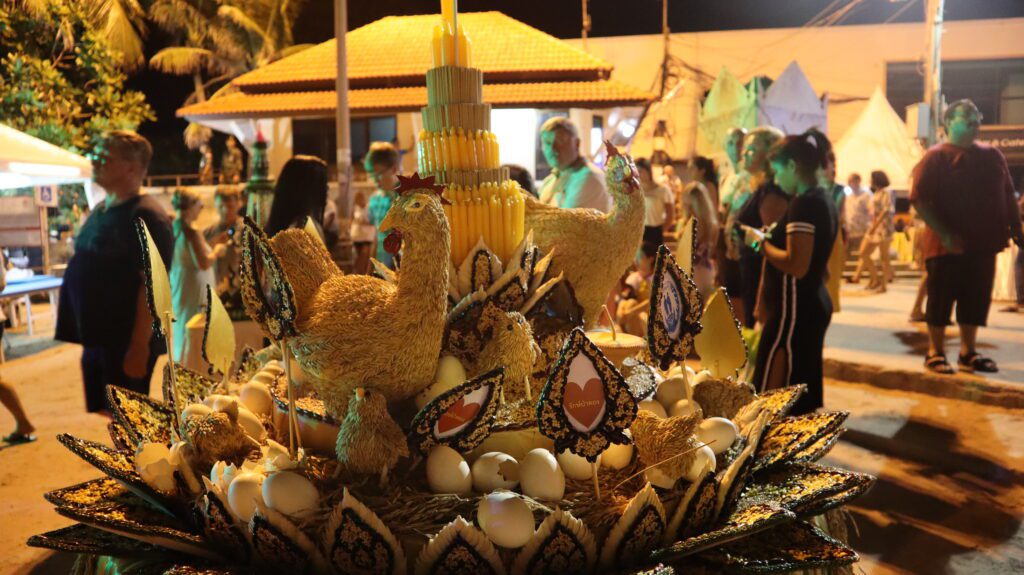Loi Krathong Festival

Historical Roots: From Sukhothai to India and China
Loy Krathong, also known as the Floating Basket Festival, traces its origins back to the Sukhothai period in Thailand, between the 12th and 13th centuries. However, its cultural influences extend beyond Thai borders, drawing inspiration from both India and China.
Decoding “Loy Krathong”: A Ritualistic Affair
The festival’s name, “Loy Krathong,” translates to “To float a ritual vessel or lamp.” This seemingly elaborate translation encompasses the core ritual: floating krathongs, buoyant baskets, onto bodies of water.
Cultural Evolution: Beyond Religious Boundaries
Loy Krathong has evolved over the years, transcending its religious origins to embrace a cultural evolution. It now incorporates romantic traditions, with couples launching a single krathong together as a symbolic gesture of connection.
Rituals and Symbolism: A Dance of Water and Light
At the heart of Loy Krathong are its rituals and symbolism. Participants release krathongs onto water bodies, symbolizing the release of negativity from their lives. Opting for biodegradable krathongs underscores the festival’s commitment to environmental sustainability.

Environmental Considerations: Balancing Tradition and Eco-Friendliness
Amidst the festivities, there’s a growing awareness of environmental impact. Choosing environmentally friendly krathongs becomes a responsibility, ensuring the festival leaves behind nothing but cherished memories.
Romantic Traditions: Love Afloat
Loy Krathong has transformed into a celebration of love, with couples sharing a single krathong as a symbol of their unity. The act of watching their krathong float away becomes a romantic gesture, strengthening the bond between partners.
Participating in Loy Krathong: A Guide for Enthusiasts
For those eager to partake in the festival, selecting the right krathong is crucial. Whether it’s a traditional design or a personalized creation, the act of releasing it into the water becomes a personal and cultural experience.
Observing Loy Krathong in Thailand: Where Water Meets Celebration
Beyond personal participation, witnessing Loy Krathong in Thailand offers a spectacular experience. Riverside locations and parks, such as Benjasiri, Benjakitti, and Lumphini, host events, providing both tourists and locals a chance to immerse themselves in the festivities.

Hotels’ Role in the Festival: Riverside Celebrations
Riverside hotels often play a significant role in Loy Krathong celebrations. Guests can enjoy organized events and gain insights into local celebrations, creating a memorable and immersive experience.
Cultural Experience for Tourists: Beyond the Surface
For tourists, Loy Krathong provides a unique opportunity to delve into Thai culture. Beyond the surface-level festivities, there’s a chance to connect with locals, learn about traditions, and create lasting memories.
Preparing for the Festival: Tips for a Memorable Experience
As you prepare to join the festivities, consider selecting a biodegradable krathong, finding a prime spot near the water, and immersing yourself in the ritual. Loy Krathong is not just an event; it’s an experience that lingers in your memory.
Significance of Water and Light: A Symbolic Connection
Water and light take center stage during Loy Krathong, symbolizing purification, gratitude, and the release of negativity. Understanding this symbolic connection adds depth to the festival’s cultural significance.
When to enjoy Loy Krathong
The Loy Krathong festival that takes place throughout Thailand every year on the full moon day of the twelfth lunar month, usually falling in November.
Conclusion: A Tapestry of Light, Water, and Unity
In conclusion, Loy Krathong weaves a tapestry of light, water, and unity, drawing from centuries of tradition while embracing the ever-changing dynamics of culture. As you release your krathong into the water, remember that you’re not just participating in a festival; you’re becoming a part of a cultural legacy.
